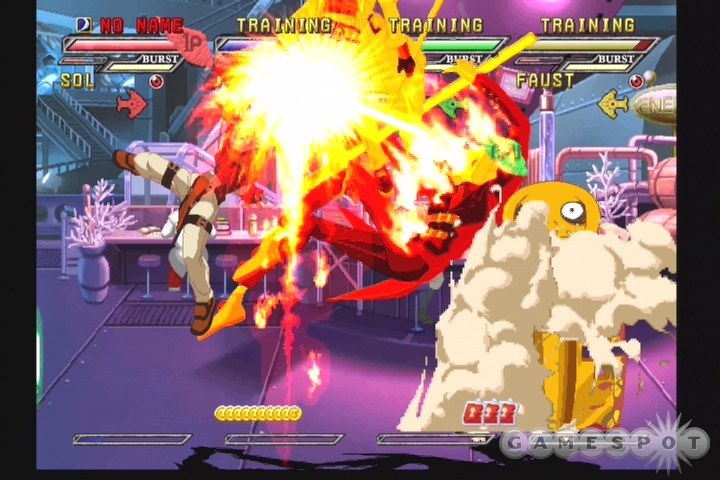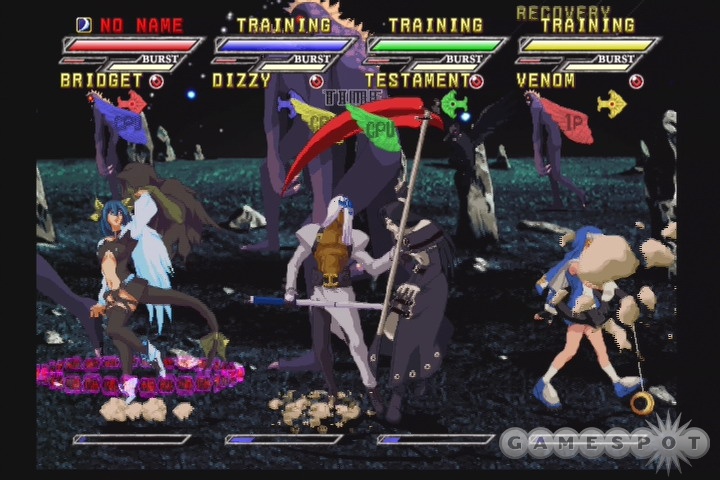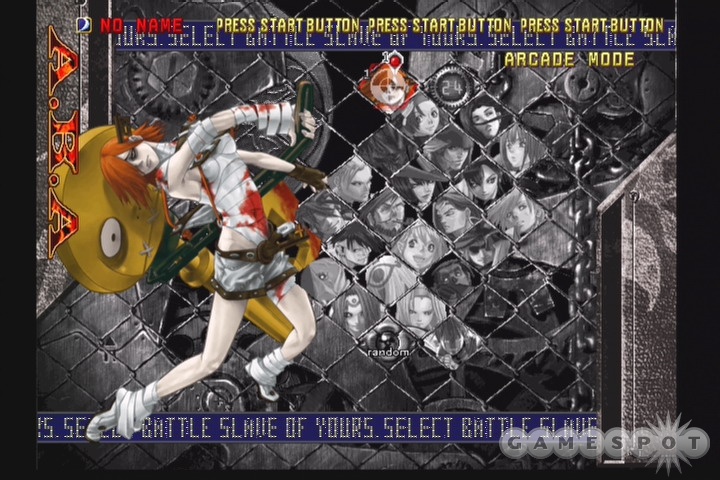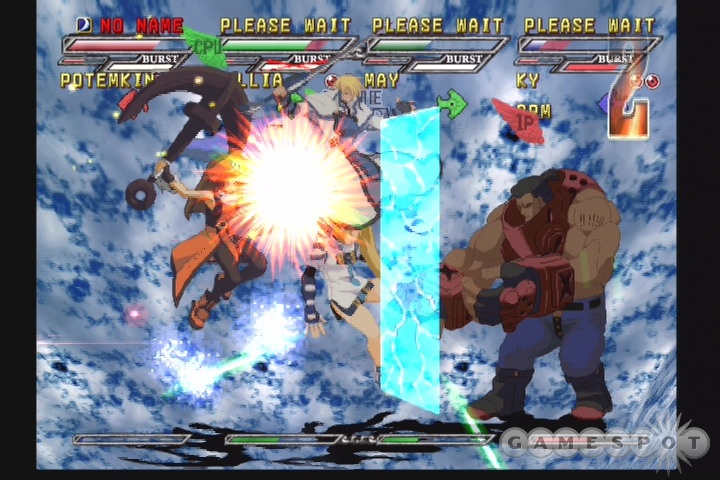Nearly two years ago, Sammy Studios released Guilty Gear X2 for the PlayStation 2, and it quickly became one of the system's defining 2D fighting games. The memorable anime-style character designs, completely off-the-wall special moves, and surprisingly deep gameplay made Guilty Gear X2 great, and proved that a company other than Capcom or SNK could make a solid 2D fighter. Now the series is back with Guilty Gear Isuka, a game that features its predecessor's familiar characters and play mechanics, but focuses on four-player simultaneous battles instead of conventional one-on-one fights. The game runs well even with four colorful characters going at it at once, but the new free-for-all style of Guilty Gear is, at best, different--not better. Meanwhile, Guilty Gear Isuka overlooks the genre's recent forays into online play, which reduces its appeal only to those living in close proximity to several other hardcore Guilty Gear fans.

Although Guilty Gear Isuka supports up to four players simultaneously (you'll need a multitap to take advantage of this feature), like most any other fighting game, it allows you to play solo or with just one another player. In fact, it's possible to pit from two to four characters in any combination; one-on-one, two-on-one, three-on-one, two-on-two, and free-for-all matches for three or four players are all possible. You can also substitute in computer-controlled players as you see fit. Two-on-one and three-on-one matches aren't as unbalanced as you might expect, since the solo player gets more health to work with to offset the other team's greater numbers. What's more, players on the same side may accidentally hit one another while trying to attack their opponents, though they can also coordinate to get on opposite sides of one of their victims and bash him or her back and forth like a tennis ball.
The multicharacter dynamic of Guilty Gear Isuka certainly changes the feel of the game, making Guilty Gear X2's already fast-paced and hectic action even more so...practically to a breaking point. In multicharacter matches, the action can certainly be pretty fun in the way that playing just about any fast-paced game with a group of friends can be fun, but it also moves at such a breakneck speed and happens so spontaneously that it winds up feeling ultimately hollower than its one-on-one predecessor.
Guilty Gear Isuka's multicharacter fighting system is not the first of its kind. SNK's very first Fatal Fury game from 1991 let two characters pound on an opponent, and Capcom later put in a better implementation of such a system in its Street Fighter Alpha games' "dramatic battle" mode. The difference is in these past games, the multicharacter gameplay was an extra feature, rather than the focus. In Guilty Gear Isuka, you can play a conventional one-on-one fight, but even these matches will be governed by the peculiar rules of the multicharacter battles that are emphasized here.

The strangest thing about how Guilty Gear Isuka plays in comparison to other 2D fighting games is that your character won't automatically turn around--so if the opponent gets behind you, you'll need to press R1 (by default) to turn to face him. This is completely disconcerting at first and remains uncomfortable for a little while, but eventually you'll get used to it. As you might expect, it becomes central to the gameplay one way or another--faster characters can now viably try to attack their opponents from behind.
In another nod to Fatal Fury, Guilty Gear Isuka's action takes place on two different planes--a foreground level and a background level. Characters can jump to the opposite plane and perform certain attacks that can hit opponents on opposite planes, but for the most part, your moves will only hit characters on the same plane that you are on. This theoretically makes multicharacter matches a bit more manageable, but in practice, it contributes to the chaos. It can be difficult to tell when a character is in the foreground or in the background, and the action gets especially messy when you've got four different characters and their crazy moves are all overlapping with one another. A long-standing issue with the Guilty Gear series has been that its graphical style, while great looking, isn't terribly clear. Rather than address this point, the game makes it harder than ever to tell just what the heck is going on. Unless you're an expert at this series and are highly familiar with all the moves and characters, you'll be bewildered by what goes on in a typical match here.
The multicharacter dynamic changes the gameplay in other ways. Now there's less of an emphasis on pulling off damaging combos, because while you're beating down one opponent (for the most part, you can only injure one character at a time), you're leaving yourself wide open. So, matches tend to devolve into button-mashing frenzies where players just peck at each other with weaker, faster moves until the losers get knocked out.

Guilty Gear Isuka is unfortunately missing its predecessor's well-done story mode. In its place is a bare-bones arcade mode that's functionally identical to most fighting games' survival modes; you don't get back all your health between matches and you just keep on fighting till you eventually get knocked out. You may continue if you lose. For some reason, your matches will occasionally be interrupted as though another player decided to challenge you in the middle of a bout against the computer. This is a neat gimmick at first, but it mostly just interrupts the pacing of the game.
The game also offers a standard versus mode, a training mode in which you can practice with and against computer-controlled opponents, as well as a color edit mode, in case the game's variety of different character colors isn't enough for you.
Guilty Gear Isuka's two other modes are less conventional. First, there's boost mode, which is basically a throwback to side-scrolling beat-'em-ups like Final Fight. You (and a friend, optionally) can take any of the game's 20-plus characters into boost mode and fight droves of mindless thugs in successively tougher stages. Boost mode does a good job of pushing lots and lots of characters onscreen, and it works well as a tribute to an antiquated style of play. Still, there's no real rhyme or reason to the proceedings, so it's easy to get bored of boost mode quickly.
Especially since it's central to Guilty Gear Isuka's factory mode in which you're invited to heavily customize your very own version of an odd character called Robo-Ky II. Robo-Ky II can learn pretty much any other special move in the game...for a price. You'll need to put him through boost mode to earn experience points, which is fairly slow going, and then you can use these points to buy moves. Of course, Robo-Ky II is an original character, so his interpretation of all the other characters' signature techniques is unique and often rather amusing. As a result, factory mode is quite possibly the most interesting part of the gameplay, but it's predicated on the tedium of having to play through a mindless side-scroller over and over.

Guilty Gear Isuka recycles the same character sprites, voices, sound effects, and animations as its predecessor, though it features some attractive, new background graphics. Amazingly, the visuals have held up very well overall, and they lend this game a clean, colorful look that's still great even though you've probably seen it before in past Guilty Gear titles. As mentioned, the game capably handles its display of copious onscreen action, so even though the artwork is mostly the same as before, Isuka still has its own particular kind of visual flair. The game also sports an excellent soundtrack, which consists purely of driving guitar rock, though during battle the audio is practically overwhelmed by up to four different characters screaming their respective catchphrases over and over.
While many fighting games this year have gone online, Guilty Gear Isuka takes a step back and to the side with its awkward multicharacter fighting system. The system certainly works, and for serious Guilty Gear fans, it'll make for some fun times as they square off with different combinations of characters. Nevertheless, there's a reason why one-on-one fights are conventional to the genre, and it's because this is where a fighting game's intensity boils down to: just you and your opponent pitted in a battle of skill. Guilty Gear Isuka features a gratuitously odd new character and some interesting modes of play, but it also lacks online play, the one feature that hardcore fans would have most wanted to see. Then again, if you're a Guilty Gear fan, chances are you're already playing online with the superior, budget-priced Guilty Gear X2 #Reload for the Xbox; Guilty Gear Isuka may make a decent follow-up rental.